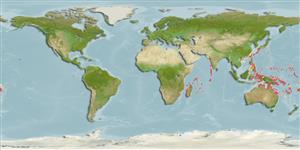Actinopterygii (ray-finned fishes) >
Perciformes (Perch-likes) >
Tripterygiidae (Triplefin blennies) > Tripterygiinae
Etymology: Helcogramma: Greek, helkos, -eos, -ous = ulcer, sore + Greek, gramma = letter, mark (Ref. 45335).
Environment / Climate / Range
Ecology
Marine; reef-associated; depth range 0 - 10 m (Ref. 6211). Tropical, preferred ?
Indo-West Pacific: South Africa and Arabia to Taiwan and New Guinea.
Size / Weight / Age
Maturity: Lm ? range ? - ? cm
Max length : 3.8 cm SL male/unsexed; (Ref. 75031)
Dorsal
spines
(total): 16 - 18;
Dorsal
soft rays
(total): 10-12;
Anal
spines: 1;
Anal
soft rays: 19 - 21;
Vertebrae: 36 - 38. Diagnosis: Dorsal fin III + XIV+ 11, 1st fin 4/5 height of 2nd fin, 1 free pterygiophore between 2nd and 3rd fin; anal fin I + 21; pectoral rays 17 (1+9+7); pelvic fin I, 2, spine short and hidden, segmented rays simple, partially united by membrane. Vertebrae 10 + 27. LL total lateral scales 39-40; tubed 22-30 scales, ends below anterior half of 3rd dorsal fin; nape, 1st and 2nd dorsal fin and anal-fin base scaleless, caudal fin base with 1 row of scales. Mandibular pores 5-8+1-2+5-8. Orbital cirrus simple. Head length 3.4 in SL; eye 2.9, maxilla 2.1 in HL. Male head with blue stripe below eye from mouth to pectoral-fin base and masked with black on ventral half; body pinkish orange with scattered dusky rosettes denser ventrally; larger ones with 5-6 light grey blotches and dusky triangular marks; median fins generally uniformly dark to black. Female paler version of male but not masked (Ref. 75031).
Adults live on rock surfaces and under ledges; common at depths less than 10 m (Ref. 6211). Eggs are hemispherical and covered with numerous sticky threads that anchor them in the algae on the nesting sites (Ref. 240). Larvae are planktonic which occur primarily in shallow, nearshore waters (Ref. 94114).
Life cycle and mating behavior
Maturity | Reproduction | Spawning | Eggs | Fecundity | Larvae
Hansen, P.E.H., 1986. Revision of the tripterygiid fish genus Helcogramma, including descriptions of four new species. Bull. Mar. Sci. 38(2):313-354. (Ref. 6211)
IUCN Red List Status (Ref. 115185)
CITES (Ref. 94142)
Not Evaluated
Threat to humans
Harmless
Human uses
More information
ReferencesAquacultureAquaculture profileStrainsGeneticsAllele frequenciesHeritabilityDiseasesProcessingMass conversion
Tools
Special reports
Download XML
Internet sources
